
Mathematics
- Subject:
- Mathematics
- Material Type:
- Full Course
- Textbook
- Provider:
- Lumen Learning
- Provider Set:
- Candela Courseware
- Date Added:
- 07/05/2018

Mathematics

Although this blog title emphasizes teaching students to analyze nontraditional texts, teachers too will appreciate the strategies the author suggests for learning to conduct textual analysis.

In his essay “The Fire,” Blaser writes, “the real business of poetry is cosmology.” He discusses poetry and the quality of its connection to the world, a world that is entered by the poet’s writing: “the processional aspect of the world has to be caught in the language also.
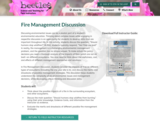
Discussing environmental issues can be a pivotal part of a student’s environmental education. Thinking about complex issues while engaging in respectful discussion is an opportunity for students to develop skills that are important throughout life. In this activity, students discuss the question, “Should humans stop wildfires?” At first, students typically respond, “Yes! Fires are bad!” In reality, fire management is a challenging environmental management problem, and the question has no simple answer. To make actual fire policy decisions you need a thorough analysis of the impacts of fires—which are not all bad!—on different ecosystems. You also need to think about the usefulness, cost, and effects of different management approaches and solutions.

This video segment adapted from NOVA explains how the sprinkler revolutionized fire safety and also features developments in fire-safety design for high-rise buildings.
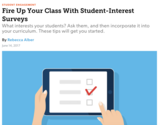
This article outlines principles for designing student interest surveys.
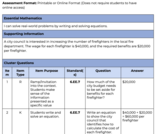
Firefighter Allocation: Standard 6.EE.7 Solve real-world and mathematical problems by writing and solving equations of the form x + a = b and ax = b for cases in which a, b and x are all non-negative rational numbers.
This formative assessment exemplar was created by a team of Utah educators to be used as a resource in the classroom. It was reviewed for appropriateness by a Bias and Sensitivity/Special Education team and by state mathematics leaders. While no assessment is perfect, it is intended to be used as a formative tool that enables teachers to obtain evidence of student learning, identify assets and gaps in that learning, and adjust instruction for the two dimensions that are important for mathematical learning experiences (i.e., Standards for Mathematical Practice, Major Work of the Grade).
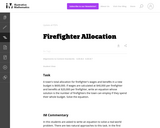
In this task students are asked to write an equation to solve a real-world problem. There are two natural approaches to this task. In the first approach, students have to notice that even though there is one variable, namely the number of firefighters, it is used in two different places. In the other approach, students can find the total cost per firefighter and then write the equation.

In this video segment from Cyberchase, Harry decides to train as a firefighter and uses line graphs to chart his physical fitness progress.

Fireflies Musical Yoga for Kids is a 12-part series, consisting of three-minute instructional videos presented by Kira Willey, nationally acclaimed kindie artist and musical yogini. It provides educators with a wonderful tool to help children connect their bodies and minds to music and positivity.

The first 10 amendments to the U.S. Constitution are known as the Bill of Rights. Those 10 amendments establish the most basic freedoms for Americans, including the rights to worship, speak, and peacefully assemble and protest their government how they want. The amendments have also been subject to much interpretation since their adoption, particularly the right to carry a gun under the Second Amendment.
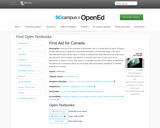
First aid is the provision of immediate care to a victim with an injury of illness, usually effected by a lay person, and performed within a limited skill range. First aid is normally performed until the injury or illness is satisfactorily dealt with (such as in the case of small cuts, minor bruises, and blisters) or until the next level of care, such as an ambulance or doctor, arrives. This book is a Canadian version of the original at Wikibooks. All references to protocols which do not comply with resuscitation standards in Canada have been removed.

Why do we have the First Amendment, and what freedoms does it guarantee? In this one-minute video, students learn about the five freedoms outlined in the amendment. A host explains each of them and identifies some of their limitations.

This resource from the National Constitution Center includes an introduction, big questions, recorded class sessions, briefing documents, slide decks, and worksheets about the first amendment of the United States Constitutuion.

This resource from the National Constitution Center includes an introduction, big questions, recorded class sessions, briefing documents, slide decks, and worksheets about the first amendment of the United States Constitutuion.

In this lesson, students will gain an understanding of how the Supreme Court's interpretation of the First Amendment changed in light of the Fourteenth Amendment. They will also analyze Thomas Jefferson's Letter to the Danbury Baptist Association, evaluate the Supreme Court's application of Jefferson's metaphor about the wall of separation between church and state, and assess how much weight should be given to Jefferson's letter in determining the constitutionality of state action with respect to religion.

This resource from the National Constitution Center includes an introduction, big questions, recorded class sessions, briefing documents, slide decks, and worksheets about the first amendment of the United States Constitutuion.

This resource from the National Constitution Center includes an introduction, big questions, recorded class sessions, briefing documents, slide decks, and worksheets about the first amendment of the United States Constitutuion.

This resource from the National Constitution Center includes an introduction, big questions, recorded class sessions, briefing documents, slide decks, and worksheets about the first amendment of the United States Constitutuion.

After completing the lessons in this unit, students will be able to summarize the contents of the First Amendment and give examples of speech that is protected by the Constitution and speech that is not protected by the Constitution.